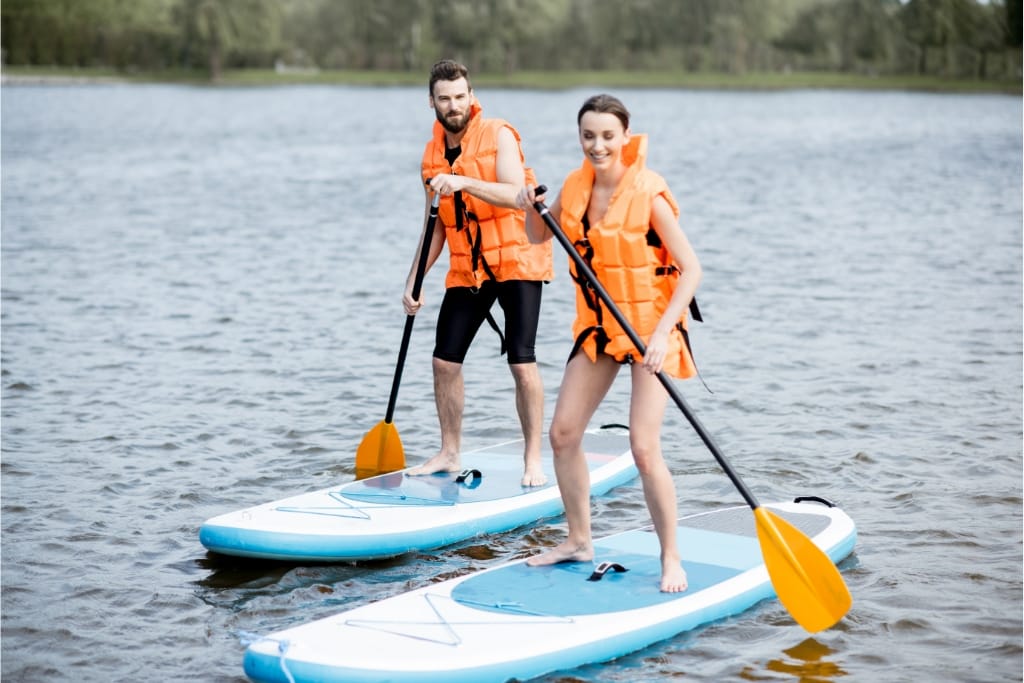Learning to paddleboard is an exciting way to explore the water while enjoying the outdoors, improving your balance, and staying active.
Whether you're gliding across calm lakes, navigating gentle rivers, or even testing the waters of the ocean, paddleboarding offers a unique experience that's accessible to almost anyone.
To help you get started on the right foot and make the most of your time on the water, check out these powerful tips that will ensure your learning process is both safe and enjoyable.
1)) Hire An Instructor
Guidance from a qualified paddleboarding instructor can make all the difference when you're just starting.
An experienced instructor will teach you essential techniques, such as proper stance, paddling form, and how to maintain balance, which helps prevent falls and injuries.
They'll also familiarize you with safety protocols and basic water etiquette, increasing your confidence on the board.
With expert support, you'll accelerate your learning curve and build a solid foundation for future adventures.
2)) Choose The Right Board
Selecting a paddleboard that suits your skill level, body type, and intended use is crucial for a positive experience on the water.
Beginners often benefit from wider, longer, and thicker boards, which provide better stability and balance while you're learning the basics.
Boards made from durable materials, such as inflatable models, are also a great choice for beginners due to their resilience and portability.
Taking the time to choose the right board will provide you with more control and comfort, making your learning experience both enjoyable and effective.
3)) Wear A Life Jacket
Wearing a life jacket is essential for ensuring your safety while paddleboarding, especially as a beginner.
Even experienced swimmers can find themselves in unexpected situations, such as strong currents or accidental falls into the water.
A well-fitted life jacket provides buoyancy and peace of mind, allowing you to focus on learning and enjoying your time on the board.
Prioritizing safety with a life jacket helps you feel secure and keeps your paddleboarding sessions worry-free.
4)) Learn Proper Paddling Technique
Mastering the proper paddling technique is key to making your paddleboarding experience more efficient and enjoyable.
A correct paddling form engages your core muscles and minimizes strain on your arms and shoulders, allowing you to paddle longer without fatigue.
Focus on holding your paddle with one hand on the top handle and the other near the shaft, and use a forward stroke that starts with your paddle blade fully submerged in the water.
Practicing proper technique early on helps you build strength, improve maneuverability, and glide effortlessly through the water.
5)) Start On Calm Water
Starting on calm water is one of the best ways to build your paddleboarding skills without unnecessary challenges.
Smooth, glassy water offers a stable environment where you can practice basic techniques like maintaining your balance, adjusting your stance, and paddling effectively.
It’s also easier to focus on mastering the movements without the distractions of waves or strong currents.
Choosing a calm body of water ensures a steady and supportive setting, helping you gain comfort and confidence as you begin your paddleboarding adventure.
6)) Check The Weather Forecast
Checking the weather forecast is a critical step in planning a safe and enjoyable paddleboarding experience.
Unpredictable weather conditions, such as strong winds, heavy rain, or sudden storms, can make the water dangerous and difficult to navigate.
Pay close attention to wind speeds and direction, as high winds can create choppy waters that challenge even seasoned paddleboarders.
Ensure that the forecast indicates calm and favorable conditions before heading out.
Being informed about the weather helps you avoid potential risks and guarantees a smoother experience on the water.
7)) Maintain Proper Stance
Maintaining the proper stance is essential for achieving better stability and control while paddleboarding.
Begin by positioning your feet shoulder-width apart near the center of the board, with your knees slightly bent to absorb any movement from the water.
Keep your back straight and your gaze forward to help maintain balance and improve coordination.
Avoid stiffening your body, as staying relaxed will enable you to adapt to the board's motions more easily.
Focusing on a balanced and natural stance allows you to move confidently and stay steady throughout your paddleboarding session.
8)) Stay Balanced
Staying balanced is one of the most critical skills to develop when paddleboarding.
Start by centering your weight on the board and evenly distributing it between both feet.
Use your core muscles to stabilize yourself and react quickly to any shifts in the water.
Keep your eyes looking ahead instead of down at your feet, as this helps maintain your posture and improves focus.
Avoid rushing your movements, as slow and deliberate actions are more effective for maintaining stability.
Focusing on balance ensures a more enjoyable and controlled paddleboarding experience.
Pro-Tip: Incorporating a balance board into your training routine can drastically improve your ability to balance on a paddleboard.
A balance board strengthens your core muscles, enhances coordination, and trains your body to respond to dynamic movements—skills that directly translate to better stability on the water.
Regular practice on a balance board helps simulate the wobbly motions of standing on a paddleboard, allowing you to develop muscle memory and confidence before you even hit the water.
9)) Use A Leash For Safety
Using a leash is a vital safety measure for paddleboarding, keeping you connected to your board at all times.
If you fall into the water, the leash ensures that your board stays within reach, preventing it from drifting away due to currents or wind.
This is particularly important when paddling in open water, where retrieving a loose board can be challenging and hazardous.
Attach the leash securely to your ankle or calf to maintain constant contact with your board.
Prioritizing the use of a leash enhances your overall safety and makes your paddleboarding sessions more secure and stress-free.
10)) Practice Getting Back On
Practicing how to get back on your paddleboard is an important skill to ensure you can recover quickly and safely if you fall off.
Start by positioning yourself on the side of the board and grabbing the handle or edge for support.
Use a strong kick with your legs to propel your upper body onto the board while keeping it steady.
Once your chest is on the board, swing your legs back into position and regain your balance before standing up.
Repeating this exercise increases your confidence in handling unexpected falls and prepares you for a smooth and worry-free ride.
11)) Avoid Overexertion
Avoiding overexertion is crucial to maintaining your energy and enjoying your paddleboarding experience.
Pushing your body too hard can lead to fatigue, poor balance, and even injury, diminishing the enjoyment and safety of your time on the water.
Pace yourself by taking regular breaks and staying hydrated to keep your stamina up throughout the session.
Pay attention to your body’s signals, such as muscle strain or exhaustion, and adjust your activity level accordingly.
Prioritizing steady effort over excessive exertion helps you remain in control and ensures a more satisfying and safe paddleboarding adventure.
12)) Keep Distance From Obstacles
Keeping a safe distance from obstacles is essential for avoiding accidents and maintaining control while paddleboarding.
Hazards such as rocks, docks, buoys, or other watercraft can pose significant risks if you paddle too close to them.
Staying vigilant allows you to spot obstacles early and adjust your path accordingly to prevent collisions or entanglements.
It is especially important to give wildlife and sensitive environments ample space to ensure a safe and respectful experience for all.
Prioritizing distance from obstacles enhances your safety and promotes a smoother and worry-free paddleboarding session.
Pro-Tip: Incorporating strength training into your routine using a home gym system or a commercial gym can significantly enhance your paddleboarding performance.
Exercises that target your core, legs, and upper body improve the strength and stability needed to maintain balance and control on the water.
Building overall muscular endurance increases your paddling power and reduces fatigue during longer sessions.
Consistent strength training helps develop the physical foundation required to master paddleboarding and tackle more challenging conditions confidently.
Conclusion
Paddleboarding is a fantastic way to enjoy the water while staying active, but ensuring your safety and comfort requires attention to key techniques.
By maintaining proper stance, focusing on balance, and practicing how to get back on the board, you set a strong foundation for your sessions.
Using a leash and keeping a safe distance from obstacles minimize risks and enhance your overall experience.
Remember to pace yourself and avoid overexertion so you can fully appreciate the joy and serenity of paddleboarding.
With these tips in mind, every paddleboarding outing can be both safe and rewarding.
Download Our Free E-book!







